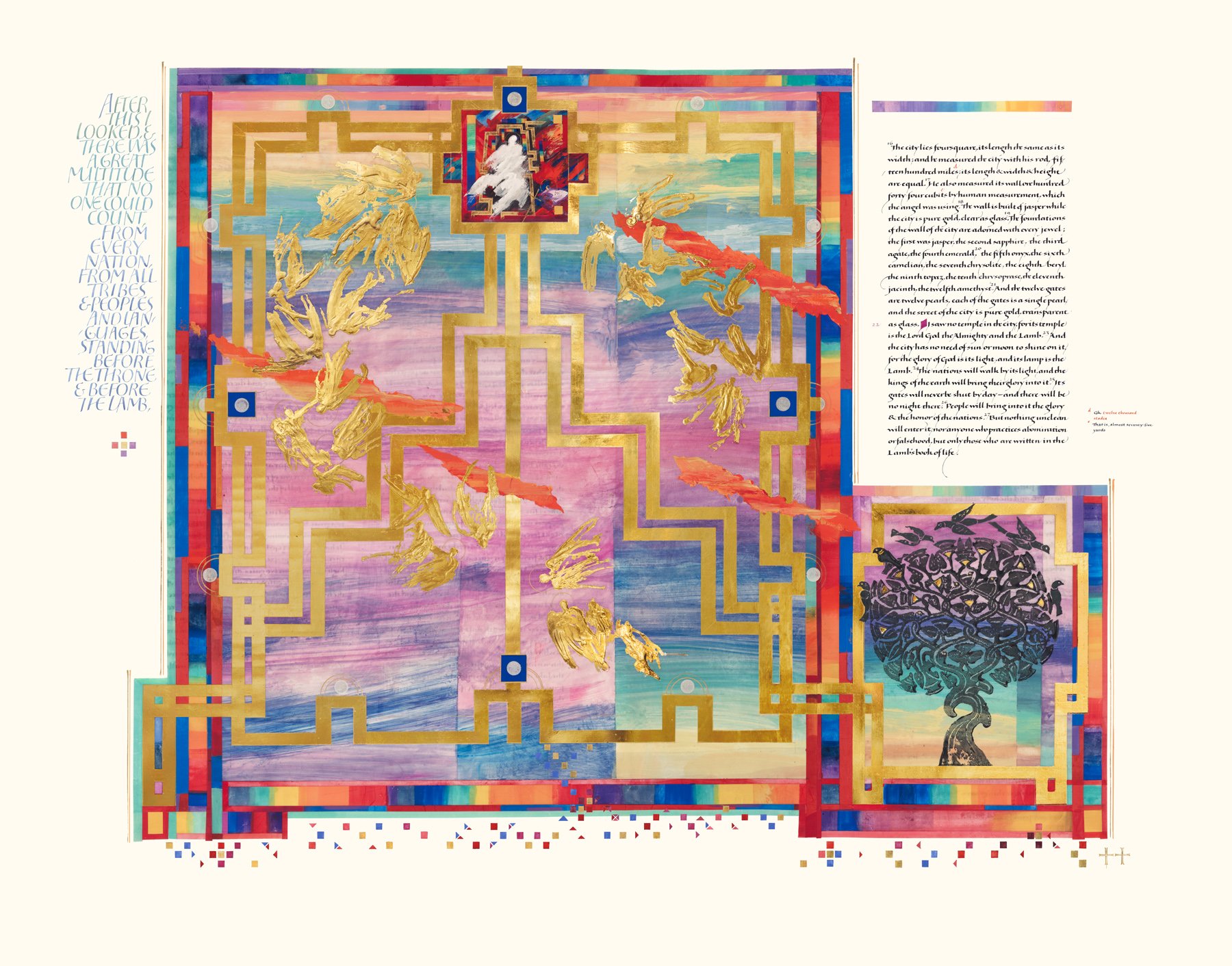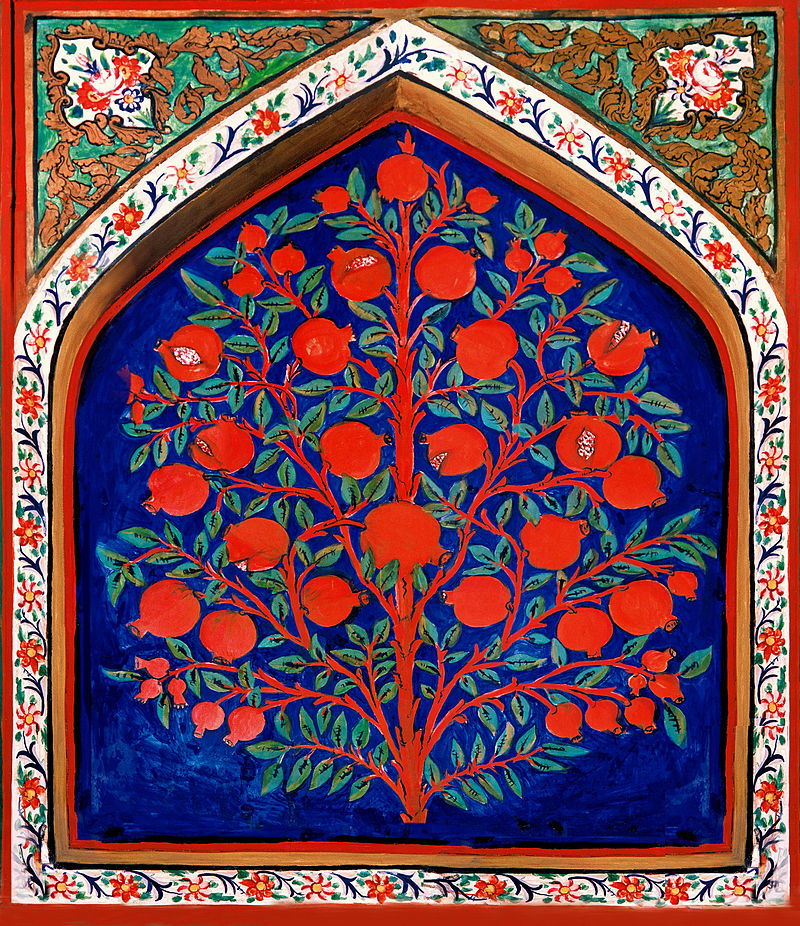The Advent Project: Week 1Chikamu

Dec. 7: A New Eternal Garden: The Tree of Life

Vision of the New Jerusalem (overall and detail view). Gilded illuminated manuscript on vellum. Artist/Scribe: Donald Jackson. © 2011, The Saint John’s Bible. Saint John’s University, Collegeville, Minnesota, USA. Used with permission. All rights reserved.

Tree of Life, Unknown artist. Painting, Seventeenth century. Palace of Shaki Khans, Azerbaijan. Public domain.
“The Four Seasons, 1. Spring” from the album Recomposed by Max Richter: Vivaldi, The Four Seasons.
Poetry:
“The Sycamore”
by Wendell Berry
In the place that is my own place, whose earth
I am shaped in and must bear, there is an old tree growing,
a great sycamore that is a wondrous healer of itself.
Fences have been tied to it, nails driven into it,
hacks and whittles cut in it, the lightning has burned it.
There is no year it has flourished in
that has not harmed it. There is a hollow in it
that is its death, though its living brims whitely
at the lip of the darkness and flows outward.
Over all its scars has come the seamless white
of the bark. It bears the gnarls of its history
healed over. It has risen to a strange perfection
in the warp and bending of its long growth.
It has gathered all accidents into its purpose.
It has become the intention and radiance of its dark fate.
It is a fact, sublime, mystical and unassailable.
In all the country there is no other like it.
I recognize in it a principle, an indwelling
the same as itself, and greater, that I would be ruled by.
I see that it stands in its place and feeds upon it,
and is fed upon, and is native, and maker.
THE NEW CITY, THE ETERNAL GARDEN, THE TREE OF LIFE
When you have a vacation to plan, what kind of place do you dream about? A penthouse suite in a luxury hotel with a view of award-winning architecture? A peaceful lake-side cabin next to sapphire water and verdant trees? These fantasies merely hint at the reality of what we will experience in God’s eternity, according to our readings from Revelation. We can look forward to a holy city where God dwells with us and all tears are wiped away, and to a garden with the river of life, the tree of life, and healing for all.
The art for today also tries to tell us what awaits believers after death. In Jackson’s illumination (based on Revelation chapters 4, 11, and 21), the rainbow colors convey ultimate splendor. The gates made of pearls and the streets made of gold convey divine harmony and priceless value. Those are just some of the wonderful attributes of the home God has prepared for us. At the top of the painting is an illustration that hints at God and the Lamb, for as Rev 21:3 says, “God’s dwelling place is now among the people.” From the throne flow ribbons of gold and red--beauty and life in place of tears, sorrow, pain, and death. To the lower right of the illumination, like an inset in a map to show more detail, is the tree of life with twelve golden fruits. The tree of life is also seen in our second piece of art, a painting from a palace in Azerbaijan. The pomegranate, with its ruby fruit, both juicy and crunchy, both tart and sweet, is a wonderful illustration of how full and glorious our eternal life will be. Seeing both styles of art—a modern take on western illumination and a work of traditional Islamic decoration—is a reminder, as our Scripture says, that “the leaves of the tree [are] for the healing of the nations.” God intends for his beautiful future to be for every ethnic group.
We read about a different kind of tree in Wendell Berry’s “The Sycamore.” A lightning strike has hollowed out its black core, and accidents over the years have scarred it. It’s still living, but it’s hardly a tree of life. We are like that tree. Although we have “healed over,” we have been distorted by our history—as we see in our “gnarls.” And all humans have “a hollow in [us] that is [our] death.” Berry’s tree is a “healer of itself” and has “gathered all accidents into its purpose.” Not so us. We need the Great Physician to heal us. We can only trust in God’s purposes, not our own, recalling that “in all things God works for the good of those who love him, who have been called according to his purpose” (Rom 8:28). The sycamore tells the poet to “stand in… place,” to endure. That can be a good lesson for us, but only half the truth, for we must also look forward to a new and heavenly place.
Sometimes our vision of heaven is faint, weak, even distorted. Today’s music by Max Richter is a re-composition of Vivaldi’s “Spring.” In Richter’s throbbing notes what echoes of the more familiar orchestral work do we hear? In Vivaldi’s composition, what echoes of a real spring day do we hear? In a similar way, images of an adorned bride, streets of gold, and a garden with a crystal river are just hazy glimmers of what God has prepared for us and what we have to look forward to. Yet, these glimpses are important to us. This “inheritance that can never perish, spoil, or fade…kept in heaven for [us]” is a source of “living hope” (I Peter 1:4). Writing in a commentary on Psalm 126, Eugene Peterson writes, “Joy is nurtured by anticipation;” thus, as we more clearly anticipate our coming new life with Jesus, our joy in this current life increases. So do our actions that align with “thy kingdom come…on earth as it is in heaven.”
Prayer:
Lord, in this world, our eyes still fill with tears at the death, sorrow, and pain that plague us. Nations are still in dire need of healing. We still feel exiled from the Garden and from your dear presence. Renew our hope that all things will be made new. Renew our joy as we anticipate the fulfillment of your promises. Help us to live and work in ways that give all people a taste of your beauty and goodness.
Amen
Dr. Kitty Barnhouse Purgason
Professor Emerita
Department of Applied Linguistics and TESOL
Biola University
For more information about the artwork, music, and poetry selected for this day, please visit our website by going to https://ccca.biola.edu/advent/2024.
Zvinechekuita neHurongwa uhu

Biola University's Center for Christianity, Culture & the Arts is pleased to share the annual Advent Project, a daily devotional series celebrating the beauty and meaning of the Advent season through art, music, poetry, prayer, Scripture, and written devotions. The project starts on the first day of Advent and continues through Epiphany. Our goal is to help individuals quiet their hearts and enter into a daily routine of worship and reflection during this meaningful but often hectic season. Our prayer is that the project will help ground you in the unsurpassable beauty, mystery, and miracle of the Word made flesh.
More









